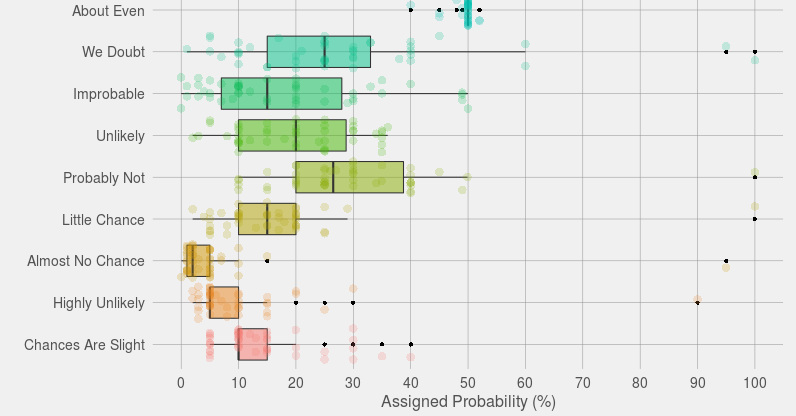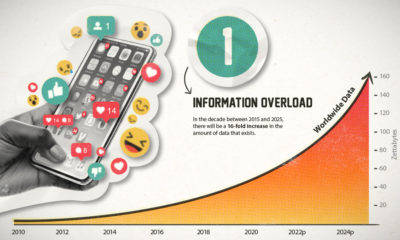Misc
Measuring Perceptions of Uncertainty
What is the difference between an event that is probable and one that is highly likely?
The two terms seem mostly interchangeable, but each individual’s interpretation is actually highly subjective. That means that when stakes are high, such as for the intelligence community or for high-ranking government officials, a slight misinterpretation in the meaning of these phrases could be a matter of life and death.
Sherman Kent and the CIA
Sherman Kent, often described as the “father of intelligence analysis”, was a CIA analyst that recognized the problem of using imprecise statements of uncertainty. Particularly, Kent was jolted by how policymakers interpreted the phrase “serious possibility” in a national estimate about the odds of a Soviet attack on Yugoslavia in 1951. After asking around, he found that some thought this meant a 20% chance of attack, while others ascribed an 80% chance to the phrase. Most people were somewhere in the middle.
Inspired by Kent’s work, a later study asked 23 NATO officers to assign actual numbers to terms like “probably”, “almost certain”, “little chance”, “unlikely”, and other words of estimated probability.
The results were fascinating:
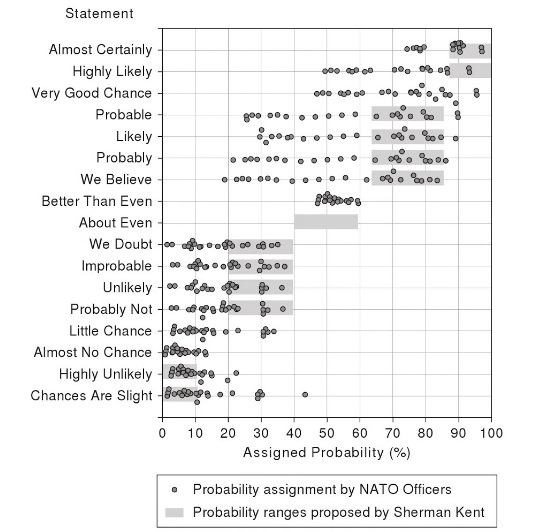
Interpretations are all over the map. The words are not precise to begin with, but it’s also worth keeping in mind that people attribute meaning to these phrases based on their personalities, backgrounds, and prior experiences. Context also matters.
How Do We Interpret These Terms?
Although the consequences are less severe for us civilians, we are stuck in the same quandary today.
We’re almost certain a deal will go through, or there’s little chance a candidate will win the presidency. People interpret these terms differently, and these small differences still impact our lives.
Reddit user zonination set out to recreate the poll to see if perceptions of words today matched up with data from the study inspired by Sherman Kent. The results below are very similar, and can help us communicate more clearly, particularly when the stakes are high.
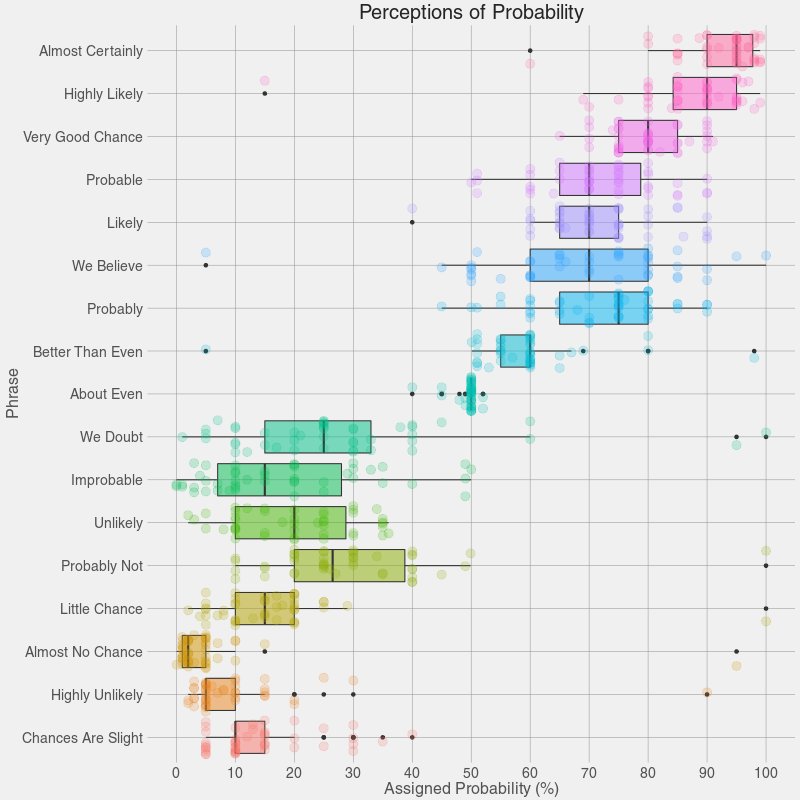
The same idea was also taken a step further, to look at potential misunderstandings that can occur when we use phrases instead of hard numbers.
For example, one person’s a few is another person’s several:
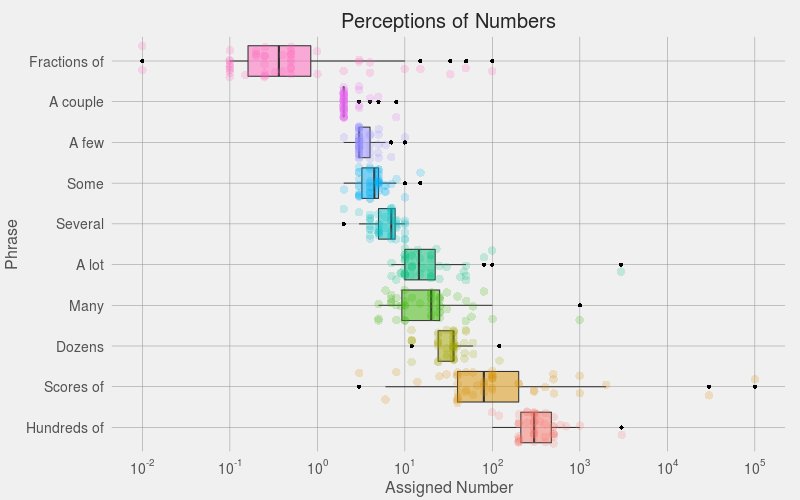
If you want to communicate with precision, it’s best to use numbers or specific odds.
Otherwise, be aware that a term like “improbable” can have a considerable range of interpretations – from 0% to 50% – depending on who you are talking to!
Maps
The Largest Earthquakes in the New York Area (1970-2024)
The earthquake that shook buildings across New York in April 2024 was the third-largest quake in the Northeast U.S. over the past 50 years.

The Largest Earthquakes in the New York Area
This was originally posted on our Voronoi app. Download the app for free on Apple or Android and discover incredible data-driven charts from a variety of trusted sources.
The 4.8 magnitude earthquake that shook buildings across New York on Friday, April 5th, 2024 was the third-largest quake in the U.S. Northeast area over the past 50 years.
In this map, we illustrate earthquakes with a magnitude of 4.0 or greater recorded in the Northeastern U.S. since 1970, according to the United States Geological Survey (USGS).
Shallow Quakes and Older Buildings
The earthquake that struck the U.S. Northeast in April 2024 was felt by millions of people from Washington, D.C., to north of Boston. It even caused a full ground stop at Newark Airport.
The quake, occurring just 5 km beneath the Earth’s surface, was considered shallow, which is what contributed to more intense shaking at the surface.
According to the USGS, rocks in the eastern U.S. are significantly older, denser, and harder than those on the western side, compressed by time. This makes them more efficient conduits for seismic energy. Additionally, buildings in the Northeast tend to be older and may not adhere to the latest earthquake codes.
Despite disrupting work and school life, the earthquake was considered minor, according to the Michigan Technological University magnitude scale:
| Magnitude | Earthquake Effects | Estimated Number Each Year |
|---|---|---|
| 2.5 or less | Usually not felt, but can be recorded by seismograph. | Millions |
| 2.5 to 5.4 | Often felt, but only causes minor damage. | 500,000 |
| 5.5 to 6.0 | Slight damage to buildings and other structures. | 350 |
| 6.1 to 6.9 | May cause a lot of damage in very populated areas. | 100 |
| 7.0 to 7.9 | Major earthquake. Serious damage. | 10-15 |
| 8.0 or greater | Great earthquake. Can totally destroy communities near the epicenter. | One every year or two |
The largest earthquake felt in the area over the past 50 years was a 5.3 magnitude quake that occurred in Au Sable Forks, New York, in 2002. It damaged houses and cracked roads in a remote corner of the Adirondack Mountains, but caused no injuries.
| Date | Magnitude | Location | State |
|---|---|---|---|
| April 20, 2002 | 5.3 | Au Sable Forks | New York |
| October 7, 1983 | 5.1 | Newcomb | New York |
| April 5, 2024 | 4.8 | Whitehouse Station | New Jersey |
| October 16, 2012 | 4.7 | Hollis Center | Maine |
| January 16, 1994 | 4.6 | Sinking Spring | Pennsylvania |
| January 19, 1982 | 4.5 | Sanbornton | New Hampshire |
| September 25, 1998 | 4.5 | Adamsville | Pennsylvania |
| June 9, 1975 | 4.2 | Altona | New York |
| May 29, 1983 | 4.2 | Peru | Maine |
| April 23, 1984 | 4.2 | Conestoga | Pennsylvania |
| January 16, 1994 | 4.2 | Sinking Spring | Pennsylvania |
| November 3, 1975 | 4 | Long Lake | New York |
| June 17, 1991 | 4 | Worcester | New York |
The largest earthquake in U.S. history, however, was the 1964 Good Friday quake in Alaska, measuring 9.2 magnitude and killing 131 people.
-

 Business2 weeks ago
Business2 weeks agoAmerica’s Top Companies by Revenue (1994 vs. 2023)
-

 Environment1 week ago
Environment1 week agoRanked: Top Countries by Total Forest Loss Since 2001
-

 Markets2 weeks ago
Markets2 weeks agoVisualizing America’s Shortage of Affordable Homes
-

 Maps2 weeks ago
Maps2 weeks agoMapped: Average Wages Across Europe
-

 Mining2 weeks ago
Mining2 weeks agoCharted: The Value Gap Between the Gold Price and Gold Miners
-

 Demographics2 weeks ago
Demographics2 weeks agoVisualizing the Size of the Global Senior Population
-

 Misc2 weeks ago
Misc2 weeks agoTesla Is Once Again the World’s Best-Selling EV Company
-

 Technology2 weeks ago
Technology2 weeks agoRanked: The Most Popular Smartphone Brands in the U.S.

